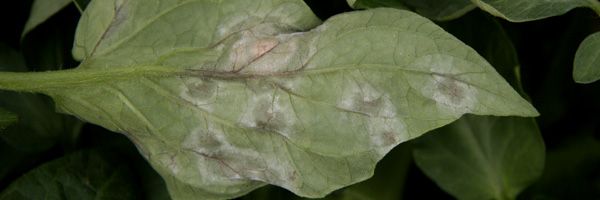
(Mont.) De Bary, (1876)
- classification : Chromista, Oomycota, Oomycetes, Peronosporomycetidae, Peronosporales, Peronosporaceae
- synonymie : Botrytis infestans Mont., (1845) ; Peronospora infestans (Mont.) de Bary, (1863)
- English names: downy mildew, late blight
Downy mildew is rampant in many production areas around the world . It is particularly formidable and destructive in regions with a humid climate , and its damage can be very important during rapid epidemics that are poorly controlled. It is not uncommon in this case to observe completely devastated crops in which the number of marketable fruits is very limited. This chromist mainly affects tomatoes grown in the open field, but it can be observed in shelters with poorly controlled climates. Like many agents of late blight, P. infestans manifests itself especially in production areas that experience prolonged periods of humidity (rains, sprinkler irrigation, fog, dew, etc.) and good weather. As its Anglo-Saxon name "late blight" suggests, it is rather late in season. It is often a constant threat and requires preventive fungicide treatments.
In France , a country with a temperate climate par excellence, P. infestans finds particularly conditions favorable for its development . Since the 1990s and the arrival of A2 strains in particular, its impact on tomatoes has sharply increased; it is now frequent and feared by all field tomato growers and amateur gardeners, especially during the summer production period. Its incidence is lower in crops under cover. Let us recall that in France, the diversity of strains isolated from tomato is greater than that observed from potato strains; the ratio of A2 strains is also greater there.
Potato and tomato late blight, caused by P. infestans , is a disease that has marked human history. Its first epidemics in Europe, in the 1840s, caused dramatic famines and the deaths of over a million people (most notably in Ireland), resulting in mass emigration of Irish people. to the United States.
The spread of this disease, from its area of origin (the Andean zone1, long contested to the detriment of Mexico), would have taken place in several stages from the 1840s. A first migration would have allowed the US- line. 1 from moving to the United States, and subsequently to Europe, probably via contaminated potato seeds. After having colonized the European continent, the mildew is said to have spread to all the potato and tomato-producing countries in the world. It should be remembered that this line, mainly present in France until the 1990s, did not seem particularly aggressive on tomatoes during the 1980s. Indeed, the epidemics occurring on this crop were often of low intensity, and the mildew gave the impression of have almost disappeared on this nightshade.
Subsequently, the increase in international trade from the end of the 20th century would be at the origin of one or more other migrations of much more aggressive strains, again from Mexico where the genetic diversity of P. infestans is very important. Thus, several strains2 were thus detected progressively in the United States from the end of the 1970s. Some of them have also been found in other countries of the American continent, but also in Europe and in many countries of the United States. world. They gradually supplanted the US-1 line.
During this period, the sexuality of P. infestans was particularly studied. It is a heterothallic chromist, its sexual reproduction requires the presence of strains belonging to two complementary compatibility groups: A1 and A2. Until the end of the 1970s, the A1 mating type was predominant in many production areas (the US-1 line is A1 type), except in Mexico where both A1 and A2 types coexisted with a ratio of 50 / 50%. New strains3 of types A1, but especially A2, were introduced in particular in Europe at the beginning of the Eighties. They are now found in many zones of production of potato of the world, but with a ratio often unfavorable to the sexual type A2. .
This last sexual type is now clearly present in tomato crops in France. The introduction of these strains has greatly modified the incidence of downy mildew in many production areas of this species. They risk increasing the genetic variability of P. infestans , and therefore increasing its aggressiveness and virulence, but also favoring its adaptation to fungicides and its conservation thanks to the formation of oospores constituting a permanent inoculum in the plots.
This Oomycete has a host range rather narrow limited to Solanaceae .





